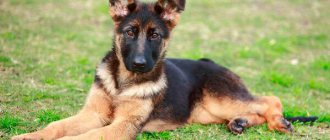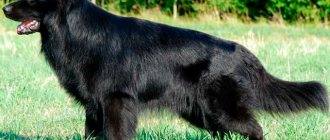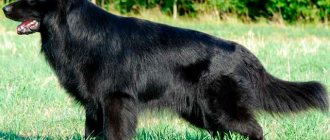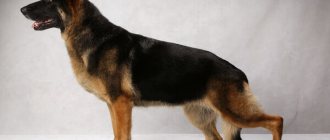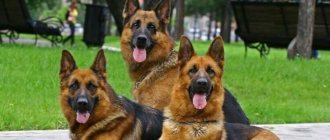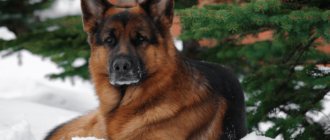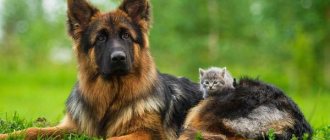Black, shiny coat, intelligent look and wonderful character - the black German Shepherd is admired by all admirers of the breed.
She is incredibly smart and very trainable.
Black color of the pet?
Is it a marriage or a valuable rarity?
Is there any difference from standard German Shepherds? Let's find out!
Origin story
The general public first learned about black German shepherds in 1906, after a dog named Ronald von Stankerburg won an exhibition.
The animal was distinguished not only by its impeccable execution of commands, but also by its unusual color: its fur was pure coal-black..
People started talking about the appearance of a completely new and unique variety of shepherd dogs, which in fact was far from the truth. The black color of shepherd dogs belongs to the standard in the same way as the usual black-and-white or zonal.
The fact is, up to a certain point, only individuals whose color was “accustomed to the eye” were allowed to be selected and bred, while the rest were discarded.
Over time, breeders realized their mistake and, in the wake of the popularity of the color, decided to fill the gap by crossing black males and females.
At this point, it turned out that all German shepherds, regardless of their color, are carriers of the black recessive gene.
Black-haired puppies appeared at the same frequency of 3% in both standard and all-black shepherds .
Training and intelligence
German Shepherds are the smartest dogs, but their intelligence and intelligence will not be revealed if the owner does not invest effort in raising the animal. No dog is born trained, and even the super-intelligent Germans require a lot of work from the owner in the training area. The same efforts are required if the dog attends exhibitions.
German Shepherd at an exhibition
Many are admired by the impeccable work of German shepherds in OKD (basics of canine training), ZKS (protective guard service) and similar types of dog sports. To get a well-trained dog that looks into a person’s eyes, you need to train your puppy from a very early age: from three months of age, attend group training, then develop the animal’s obedience and intelligence individually.
A natural desire to learn, constantly interact with a person and a willingness to obey is the basis that is embedded in purebred BUT puppies.
It will depend only on the owner whether the dog will become like what is shown in films about police officers, or whether it will remain a mediocre guard of the yard territory
Marriage or breed?
Contrary to all existing misconceptions, the black German shepherd is not a breed and not a separate breed. This is a standard German Shepherd whose coat color is much less common than the others.
Australia is the country where black German Shepherds are most popular.
It is noteworthy that in this country, until the 21st century, individuals with pure black fur were considered dangerous to humans - the color of the raven wing gave them an image of aggression and malice.
Interesting Facts
- In Australia, it was previously believed that an all-black dog was aggressive and ferocious. Now in Australia, coal German shepherds are the most popular.
- There are snow-white German Shepherds, but unlike black ones, their color is considered a deviation from the norm. The white dog cannot participate in exhibitions and is not allowed for breeding.
- German Shepherds are ranked as the third smartest breed in the world.
- During World War II, shepherd dogs were actively used in military operations, which is why the breed was on the verge of extinction.
Description of pets
The German Shepherd is a dog distinguished by excellent physical endurance and developed muscles - the black-haired shepherd is no exception.
The main nuances of the breed are the stretched line of the body, strong bones, pronounced withers and a smooth line of the back turning into a rather thick and curved tail..
This body type allows dogs to be strong, but at the same time maneuverable. This makes them excellent shepherds, guards and bloodhounds.
Expert opinion
Kozhevin Semyon Kirillovich
Expert dog handler.
“The black German Shepherd has the same disposition as a shepherd with any other color: it is brave, smart and quite willful. Its owner must understand that the pet needs education and training, and without proper effort, a promising dog will turn into an uncontrollable animal.”
What to feed
If you get a German Shepherd, you must clearly understand the rules of its nutrition. After all, this is the basis of keeping an animal. Undereating is as bad as overeating. Therefore, strictly control the amount of food you consume, especially before physical training. The fact is that the anatomical structure of the digestive tract of dogs promotes bending and movement of the stomach during movements. In cases of overeating, this threatens intestinal volvulus.
Important! Experts advise feeding the “Germans” after a street walk
Puppy
When choosing a pet, give preference to those that have already been weaned from their mother. This will make it easier for you to introduce new foods into your diet.
If you have a very small shepherd in your arms, then take into account the rules for feeding it:
- For the first 2 weeks after birth, puppies should drink only breast milk. If for some reason the mother is not present, the natural process will have to be carried out using a pacifier and bottle. The liquid must be heated to 28°C. Plan to feed at the same time and at regular intervals. The puppy should consume 2/3 cup of milk per day.
- From two weeks of age, the daily portion of food is gradually increased to 2 glasses, while reducing the number of feedings (ideally there should be 6).
- When the dog is 1 month old, it can be offered its first complementary foods in small portions. These are porridges, meat, cottage cheese, soups, vegetable purees.
- In the period from 2 to 4 months, the puppy is fed 5 times a day with a daily food intake of 3–3.5 glasses.
- From 4 months, the number of meals is reduced to 4, and the total daily portion is increased to 1 liter.
- When the dog is six months old, it is fed three times a day, feeding about one and a half liters of food.
- One-year-old animals are transferred to two meals a day.
Important! Do not give puppies boiled potatoes. In this form, the root vegetable is poorly digestible
It is best served raw. Moreover, starch has a very beneficial effect on fur.
For puppies, breeders recommend the following products:
- meat (it is better to give it raw, but you cannot switch the animal to this product only);
- offal (can be given from 4–6 months);
- raw beef bones (useful from one and a half months of age, but not recommended after changing baby teeth);
- raw or boiled sea fish without bones (given from 4 months instead of meat, but not often);
- raw egg yolk mixed with porridge or kefir and boiled white;
- cottage cheese, Adyghe cheese, feta cheese, hard cheese;
- dairy products (must be present in the daily diet);
- brown bread (given to one and a half months of age, soaked in bone broth);
- white bread croutons (acceptable from 2 months);
- buckwheat, rice, rolled oats, corn and wheat cereals;
- vegetables (cabbage, beets, carrots, potatoes, cabbage, pumpkin, rutabaga);
- greens (garlic cloves, chopped onions, dill, parsley);
- raw berries, fruits and dried fruits (all seedless berries, as well as grated apples, pears, strawberries, raisins).
Important! As the dog grows, the owner needs to ensure that his pet’s diet does not contain an excess of calcium, as well as vitamins A and D.
Animal character
For quite a long time there was a stereotype that the black German shepherd is an aggressive and cruel animal. This is nothing more than speculation based on his unusual appearance.
Black color does not affect the psyche and character of the animal in any way..
Representatives of this color are very smart, active, selfless and wary of strangers, but are not prone to displaying causeless aggression.
At first, as with all shepherds, it can be difficult: Germans don’t trust people they don’t know well, but once you make friends, the situation will change dramatically.
It's hard to imagine a more loyal four-legged friend than the German Shepherd.
Distinctive features
Pedigree description of black shepherd dogs:
- General form. A fairly large dog of an elongated format with a strong body structure. Calm and balanced behavior. A distinctive feature is a creeping gait.
- Height and weight. The height of male dogs should not exceed 65 cm at the withers, weight no more than 40 kg. For females – 63 cm and 32 kg, respectively.
- Head. Proportional to the body, wedge-shaped. The width of the skull is ideally equal to the length. The eyes are dark brown, almond-shaped, and may sometimes appear slightly slanted. The ears are large, erect, and have dense cartilage.
- Muzzle. Strong, powerful jaws. Bite – scissors, 42 teeth. The jowls are dark in color, fit tightly to the jaw, but not dry. The length of the muzzle is equal to the length of the jaw. The nose pigment is only black. A small hump is acceptable.
- Neck. Strong, muscular, medium length, dewlap undesirable. Smoothly transitions into the line of the withers, the angle relative to the body is about 45 degrees.
- Frame. Sturdy, muscular, strong, without dampness. The back is moderately long, the loin is wide. The croup is long, slightly sloping (about 23 degrees relative to the horizon). The chest is moderately wide and deep (chest depth 45 - 47% of the height at the withers). Fortbreast is well expressed. The ribs are oval.
- Limbs. The shoulder blades and shoulders are the same length, the angle of articulation is no more than 110 degrees. The front legs are straight and parallel to each other when viewed from the front. The toes are tightly gathered into a ball; dewclaws are absent. The thighs and lower legs are visually the same length, the thigh is strong and muscular. The hock joints are strong, the metatarsus is vertical to the hock joint.
- Tail. The tail is saber-shaped, set low, never rising above the level of the back. The length of the tail should be below the hock but above the middle of the metatarsus.
- Wool and color. Black German Shepherds come in 2 variations: long-haired and short-haired. In both subspecies, any inclusions or markings of other colors are undesirable. The guard hair is of medium hardness, with a dense dense undercoat.
Varieties of color
According to canine statistics, black German Shepherds appear only in 3% of cases out of 100.
The reference color is pure, black without whitish spots or tan marks. Such individuals are much more expensive than their relatives due to their rarity.
The dominant and classic color is still considered saddleback or zoned red and tan . It was them who were constantly sectioned and brought their external parameters to perfection, without thinking about black dogs.
Health of Black Shepherds
Particular attention should be paid to the health of the dark German Shepherd.
An animal of this breed is susceptible to diseases such as:
- Colds,
- Tendency to allergies and dermatological diseases,
- joint dysplasia,
- Digestive disorders.
The dog must be taken to the veterinarian for examinations. When the animal has not yet grown to adulthood, it is important to give it the necessary vaccinations and give it additional vitamins, if required.
If the shepherd lives outdoors, you should inspect the animal’s paws every evening for any splinters and thorns. If there are any, they are immediately treated with hydrogen peroxide, brilliant green or iodine. Otherwise, it may lead to inflammation.
Types of black German Shepherds and what they look like in the photo
As for the varieties, everything is exactly the same as in the case of the standard: a German shepherd with black hair can be short-haired or long-haired.
NOTE!
Short-haired black German Shepherds have slightly longer coats than standard ones.
In this case, the coat should be dense, with a thick undercoat, without bald spots or tangling..
Grey
Greek and Central Asian, South Russian Shepherd Dogs, Briard - these are the breeds that can have a gray color.
An interesting breed is the Puli, which comes in white, gray, and other colors.
Puli dog
The fur is formed into cords that completely hide her brown eyes. Puli is a very smart and loyal, but also a serious dog.
If she thinks her owner is in danger, she will attack without warning.
The Catalan Shepherd is found in both gray and other colors.
Catalan Shepherd
Her coat is hard, with a thick undercoat, the dog is decorated with a lush collar, mustache, beard, and bangs. The wool is long.
The dog's appearance is very funny, and his character is energetic and cheerful.
The Romanian Mioritic Shepherd is massive, covered with thick white or fine hair, sometimes with different spots. She is surprisingly obedient and extremely affectionate.
Romanian Mioritic Shepherd Dog
Only the owner himself can train her: she “falls in love” with only one person, once and for all. The Romanian Shepherd will never betray its owner, even if he is no longer there.
Dimensions, weight and other distinctive features
Black German Shepherds differ from their “classic” counterparts not only in their unusual color.
There are several distinctive features that are also worth mentioning:
- They are larger - the height of cables varies from 60 to 68 cm, females - from 55 to 60 cm. The weight is also slightly higher than normal: males weigh from 45 to 50 kg, females - 37-40 kg.
- Straight back - standard individuals have a more convex back.
- Long coat - hairs on the nape and chest resemble a mane.
In other respects, these are all those classic German shepherds.
Pigmentation
With any acceptable color, a German Shepherd must have pronounced pigmentation . The dye, present in the iris of the eyes, skin and fur, signals the biological usefulness of the body. For shepherd dogs, the two main colors are black (eumelanin pigment) and red (phaeomelanin pigment). The first changes as it spreads over the body, and the second (tan) changes in saturation.
Important! A properly pigmented Sheepdog is black, visible over at least 50% of the body, as well as strong, uniform tan ranging from gold to intense reddish. Weakened pigmentation is not welcome, but sometimes it is forgiven. For example, the reduction of the black mantle on the back to the size of a spot is not particularly attractive, but on red shepherds this defect is almost unnoticeable.
Pigmentation defects in German Shepherds also include:
- lack of a “mask”;
- blurred (weak) saddle cloth;
- large white markings on chest;
- white tip of the tail and paws (“socks”);
- pink gums;
- light claws and nose;
- Lightening of the iris (yellow eyes).
Dark black nails are an indicator of the animal's pigmentation: Sheepdogs with weak saddle coats have mostly dull/lightly colored nails.
Return to content
Life expectancy and health
German Shepherds, regardless of color, are quite strong, strong and hardy animals.
However, like all other dogs, they have their own “breed weaknesses” - problems with vision, digestive tract, as well as elbow and hip dysplasia .
As for life expectancy, German Shepherds live from 9 to 13 years.
The better the living conditions and food , the longer the pet lives . The same goes for his health.
Vaccinations and susceptibility to disease
The first vaccination is given to the puppy at the age of 2 months. He is given a complex vaccine. After four weeks, revaccination against the same diseases is carried out. Ten days after this, the baby is released onto the street.
The rabies vaccination is given after all teeth have been completely replaced - at 6–8 months. The next time revaccination is done at 12 months.
The Black German Shepherd is renowned for its good health. Like all large breed dogs, they do not live very long - 9–12 years.
The Black Shepherd is prone to the following diseases:
- Hip dysplasia.
- Eye diseases.
- Diseases of the cardiovascular system.
- Inflammation of the gastrointestinal tract and volvulus.
How does he treat children and other pets?
German Shepherds are good-natured and non-aggressive creatures. Other animals, especially smaller ones, are treated in a friendly and condescending manner. They calmly and unemotionally endure all the attacks of cats and the loud barking of small dogs.
IMPORTANT!
In adolescence, especially among males, competition for the position of leader may arise, however, with proper upbringing, this situation is quickly corrected.
As for small children, the Germans perceive them as “younger members of the pack” and protect them in every possible way.
A shepherd dog can become your baby's first and reliable friend..
Eye and skin colors
The breed standard states that the iris should be as dark as possible. Black eyes are expressionless, especially against the background of the mask.
The iris is not a determining sign in culling a dog. Pigmentation may contrast with the coat. Some breeders give preference to individuals whose iris color matches the general color scheme.
The lining of the mucous membrane in pets with a dim color is saturated, spotting is noted on the mucous membrane of the tongue. The skin is blue-gray, in areas where the coat is bleached it is pinkish, like the ears and anus, with the exception of dark-coated dogs.
Standards
The eyes are medium-sized, oval, almond-shaped, slightly obliquely spaced, shallow-set. The iris ranges from light brown, blue, to dark brown.
The color of the coat is not related to the color of the eyes. According to the requirements, the skin is ashy with a bluish tint, in reddish-yellow places it is pink, and does not form folds.
Deviations
A very light color of the iris is considered a breed fault. Heterochromia and yellow iris are not accepted. These appearance features do not pose a health hazard, but they distance the animal from the breed ideal.
The round shape of the eyeball, deep seating are disqualifying signs. Hanging folds of skin located on the neck are a deviation from the breed.
Recommendations for care and maintenance
Despite the rare “luxury” color, the black shepherd is also undemanding and unpretentious, like its standard-colored relatives. She will easily adapt to life both in a private home and in an outdoor enclosure. Dog experts consider the second option to be a higher priority.
So, to make your pet feel as comfortable as possible, you need:
- Eliminate drafts and dampness - there should be a dry, warm and spacious booth in the enclosure. Make sure in advance that the roof does not leak in the rain and does not freeze through in winter. As for the floor, make the booth on a small foundation so that water does not flow inside.
- Regularly inspect the ears and eyes for dirt and promptly clean them with a soft cloth soaked in a special antiseptic solution or strong tea leaves.
- Brush the coat once a week. During molting - once every 3 days. And it is also very important to ensure that tangles and icicles do not form on the stomach, chest and nape.
- Bath as needed - no more than 3 times a year, except in autumn and winter. Frequent water procedures cause the coat to become dull and brittle.
- Trim nails once a month - this applies to domestic dogs. In individuals living outdoors, their claws wear down naturally.
- Spend time on physical activity and training - take your dog for a walk twice a day. It is advisable that one walk include elements of training and education.
Aviary or booth? Is it suitable for living in an apartment?
As mentioned earlier, a spacious enclosure with a comfortable booth is an ideal option for such an active dog as a German Shepherd.
However, this does not mean that it cannot be kept in an apartment.
The main condition: provide the dog with a comfortable and quiet place to sleep and devote time to physical activity and walks outside.
Advantages and disadvantages of the breed
The main advantages of a black German are:
- Fast learner. Germans are great at learning commands and learning different tricks.
- Intelligence. They are smart and quick-witted.
- Love for children and other pets.
- Unpretentious care, quick adaptation to any conditions.
- Not picky about food. The main thing is to balance the diet and feed at the same time.
- Devotion and fidelity.
- Protection of the owner from any stranger (and not only). The owner will be protected even from those who try to argue with him or raise their voice.
The disadvantages include:
- Large amount of lost hair. You will have to get used to cleaning the house every day.
- "Doggy" smell.
- Excessive energy. If you don’t give your pet enough time, he will begin to destroy everything that surrounds him.
- Damage to furniture and other things. This is true if your pet lives inside a house or apartment.
- Barking. The German's voice is quite loud and sonorous, so you'll have to get used to it.
Basic feeding rules
A balanced diet is the key to your pet's health and well-being.
Shepherds can be fed with both natural products and ready-made industrial food intended for large breeds of dogs..
In both the first and second cases, it is very important to comply with the KBJU. The animal should not suffer from nutritional and micronutrient deficiencies.
Economy class food is not suitable for feeding German Shepherds as it has extremely low nutritional value. The best choice is super premium and holistic products.
As for a natural diet, you need to focus on lean meat, high-quality offal, vegetables, herbs and cereals.
Starchy vegetables (potatoes, sweet potatoes, beets), baked goods and spices are prohibited. To avoid digestive problems, feed your dog before exercise, not after, as dogs' stomachs shift to the side when they run.
To maintain the rich charcoal color of the coat, add fish oil and dried seaweed to your pet’s diet.
Caring for puppies
Usually the puppy moves into the new year at two months of age. Before the first two vaccinations have been given, he should not be allowed outside.
At first, the baby will have to be fed 5–6 times a day. Until the age of four months, milk is added to the diet; after reaching this age, low-fat fermented milk products are given.
For a puppy, you can put a small enclosure where the baby will stay while the owner is not around. A diaper is also placed there, on which the puppy can go to the toilet.
The baby should have a lot of toys. The baby is raised and trained from the first days of his arrival in his new home. The puppy is taught to respond to its name, know where its place is, and respect its owner as the head of the pack.
How to choose?
In addition to the puppy’s appearance, it is also worth paying attention to its behavior and intelligence.
Basic selection tests will help you with this.:
- Enter the enclosure with the mother and puppies - the mother should show alertness, but without obvious aggression.
- Squat down and attract the attention of the puppies - mark the most curious and daring ones.
- Watch the feeding process - which of the babies responded to the call the fastest and went to the bowls?
- Throw the ball - pay attention to those who joined the game and began to study the subject. Cowardice and timidity are disqualifying characteristics for the breed.
- Offer a new dog toy - show it on your outstretched palm. Celebrate those who showed courage and curiosity.
Signs of health and illness are also important. If puppies have festering eyes, ears, or bad breath, think about whether you should trust the breeder.
CAREFULLY!
An alarming signal is that you are not shown all the puppies from the litter, although you know for sure that none have found new owners yet.
Be sure to check out the pedigree of your future pet . It is advisable to look not only at the mother and father, but also several generations ago.
Read more about the rules for choosing a German Shepherd puppy here.
Color and coat type
Despite the name of the breed, some species contain chocolate shades of fur on the limbs and shoulder apparatus. The world-famous dog handler Moore Ray, who bred the black German, believed that the coat of a puppy born from coal-black parents (over several generations) loses all foreign shades.
Professional dog breeders mate Germans of other colors with black ones to improve the pigmentation of the species. However, this only works if there are already dark-haired representatives in the family. Often, when mating a black German and a saddle shepherd, half of the puppies are obtained with a pale saddle shade of coat.
Professional dog handlers confirm that today the black color of the dog has practically disappeared. But, thanks to nurseries and the participation of professional breeders, the color is gradually returning, and the dogs are taking first place in the race for exemplary conformation.
